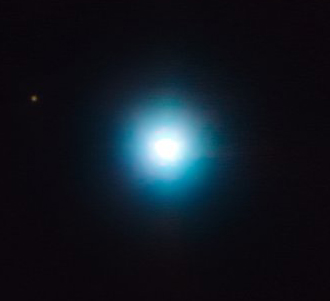June 15, 2016. IFA News
 Astronomers search for planets around other stars using a variety of methods. One of them, very succesfull, is specially effective for detecting planets in wide orbits around young stars, because the light reflected off the planet is not overwhelmed by the light of its host star, and so its easier to detect. Dr. Nikolaus Vogt, from IFA, is part of the research team that took the "picture of the week" for ESO (potw1624).
Astronomers search for planets around other stars using a variety of methods. One of them, very succesfull, is specially effective for detecting planets in wide orbits around young stars, because the light reflected off the planet is not overwhelmed by the light of its host star, and so its easier to detect. Dr. Nikolaus Vogt, from IFA, is part of the research team that took the "picture of the week" for ESO (potw1624).
The image shows us a T-Tauri star named CVS030, distant 1200 LY from the Earth, in the 25 Orionis Group (a little to the northwest of well know Orion´s Belt). In 2012, astronomers discovered an exoplanet (CVSO 30b) orbiting around that star, by using the photometry method of light transit (the light from the star decreases slightly every time the planet passes in front of it). And, when astronomers went back to examine the star again, this time using varied telescopes, combining observations obtained from the VLT in Chile, the W.M.Keck in Hawaii and the Calar Alto Observatory in Spain, they found what would be a second planet. To produce the image they exploited astrometry information provided by NACO and SINFONI instruments from VLT. This new exoplanet, called CVSO 30c would be the small dot that can be seen in the upper left corner of the image (the bright object is the host star). Whereas the previous planet detected orbits very close to the star in less than 11 hours at a distance of 0.008 AU, CVSO 3c orbits at a distance of 600 AU, taking 27.000 years to complete a single orbit. As reference, Mercury orbits at a distance of 0.39 AU from our Sun, while Neptune does so at a little over 30 AU. If CVS0 30c is confirmed to orbit CVS030, it would be the first stellar system that has a close planet detected by the transit method as well as a distant planet detected by direct imaging. Astronomers still investigate how such an exotic system formed in such a short time period, as the star is only 2.5 million years old. Its possible that both planets had some interaction in the past, dispersing them and placing them in their current orbits. Image: Star CVS0 30 in the ESO Picture of the Week, credits, ESO/SChmidt et al.
Associated link: Scientífic paper, Schmidt et al.





